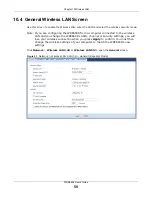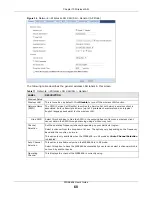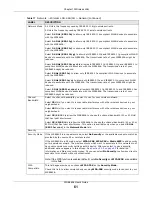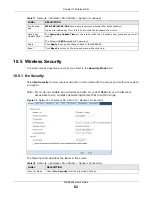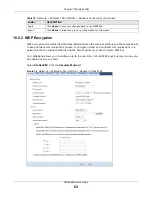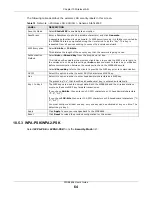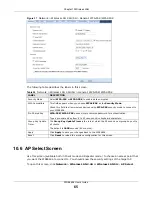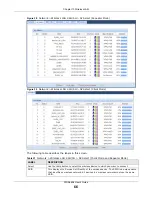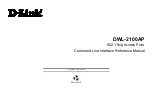
Chapter 10 Wireless LAN
WRE6606 User’s Guide
64
The following table describes the wireless LAN security labels in this screen.
10.5.3 WPA-PSK/WPA2-PSK
Select
WPA-PSK
or
WPA2-PSK
from the
Security Mode
list.
Table 19
Network > Wireless LAN 2.4G/5G > General: Static WEP
LABEL
DESCRIPTION
Security Mode
Select
Static WEP
to enable data encryption.
PassPhrase
Enter a Passphrase (up to 26 printable characters) and click
Generate
.
A passphrase functions like a password. In WEP security mode, it is further converted by
the WRE6606 into a complicated string that is referred to as the “key”. This key is
requested from all devices wishing to connect to a wireless network.
WEP Encryption
Select
64-bits
or
128-bits
.
This dictates the length of the security key that the network is going to use.
Authentication
Method
Select
Auto
or
Shared Key
from the drop-down list box.
This field specifies whether the wireless clients have to provide the WEP key to login to
the wireless client. Keep this setting at
Auto
unless you want to force a key verification
before communication between the wireless client and the WRE6606 occurs.
Select
Shared Key
to force the clients to provide the WEP key prior to communication.
ASCII
Select this option in order to enter ASCII characters as WEP key.
Hex
Select this option in order to enter hexadecimal characters as a WEP key.
The preceding "0x", that identifies a hexadecimal key, is entered automatically.
Key 1 to Key 4
The WEP keys are used to encrypt data. Both the WRE6606 and the wireless stations
must use the same WEP key for data transmission.
If you chose
64-bits
, then enter any 5 ASCII characters or 10 hexadecimal characters
("0-9", "A-F").
If you chose
128-bits
, then enter 13 ASCII characters or 26 hexadecimal characters ("0-
9", "A-F").
You must configure at least one key, only one key can be activated at any one time. The
default key is key 1.
Apply
Click
Apply
to save your changes back to the WRE6606.
Reset
Click
Reset
to reload the previous configuration for this screen.










